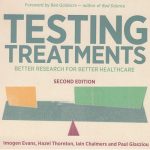
Confidence Intervals – CASP
The p-value gives no direct indication of how large or important the estimated effect size is. So, confidence intervals are often preferred.
| 0 Comments | Evaluated
Know Your Chances
This book has been shown in two randomized trials to improve peoples' understanding of risk in the context of health care choices.
| 0 Comments | Evaluated
Making the most of the evidence in education
A pamphlet to guide people using research evidence when deliberating about educational policies.
| 0 Comments
Beginners guide to interpreting odds ratios, confidence intervals and p values
A tutorial on interpreting odds ratios, confidence intervals and p-values, with questions to test the reader’s knowledge of each concept.
| 0 Comments
P Value in Plain English
Using simple terms and examples, this blog explains what p-values mean in the context of testing hypotheses in research.
| 0 Comments
Making sense of randomized trials
A description of how clinical trials are constructed and analysed to ensure they provide fair comparisons of treatments.
| 0 Comments
Statistical Significance – CASP
In a well-conducted randomized trial, the groups being compared should differ from each other only by chance and by the treatment received.
| 0 Comments
P Values – CASP
Statistical significance is usually assessed by appeal to a p-value, a probability, which can take any value between 0 and 1 (certain).
| 0 Comments
Making sense of results – CASP
This module introduces the key concepts required to make sense of statistical information presented in research papers.
| 0 Comments
Los intervalos de confianza en investigación
¿Para qué sirven los intervalos de confianza en los estudios de investigación?
| 0 Comments


Interpreting 95% Confidence Intervals
Gilbert Welch’s 9-min video on how 95% confidence intervals relate to p values.
| 0 Comments

Significant Others
Statistical significance does not always mean meaningful or practical significance.
| 0 Comments
False Precision
The use of p-values to indicate the probability of something occurring by chance may be misleading.
| 0 Comments
P-values and the role of chance
Gilbert Welch’s 10-min video on p-values and assessing the likelihood that a difference between treatments is due to chance.
| 0 Comments
Understanding Confidence Intervals
A 4-min video explaining the concept of confidence intervals and how they are calculated, with helpful diagrams and examples.
| 0 Comments
Mixed Messages about Statistical Significance
A webpage explaining the difference between statistical and practical significance.
| 0 Comments
Type I and Type II errors, and how statistical tests can be misleading
Gilbert Welch’s 12-min video explaining Type I and Type II errors, and how statistical tests can be misleading.
| 0 Comments
Reporting results of studies
Dr Chris Cates' article discussing how to report study results, with emphasis on P-values and confidence intervals.
| 0 Comments
Viva la Evidence!
A brilliant song and video by James McCormack explaining the basics of evidence-based medicine.
| 0 Comments
What does the Cochrane logo tell us?
This video and animated slide presentation prepared by Steven Woloshin shows how the Cochrane logo was developed, and what it tells us.
| 3 Comments
What does a “significant difference” between treatments mean?
Well, this is a trick question, because ‘significant difference’ can have several meanings. First, it can mean a difference that […]
| 2 Comments
Assessing the role that chance may have played in fair tests
The role of chance can lead us to make two types of mistakes when interpreting the results of fair treatment […]
| 4 CommentsNo Resources Found
Try clearing your filters or selecting different ones.
Browse by Key Concept
Back to Learning Resources homeJargon buster
About GET-IT
GET-IT provides plain language definitions of health research terms
